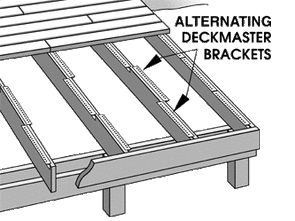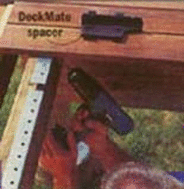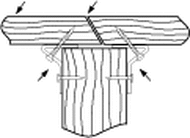
Helpful Tools In addition to standard carpentry tools, the following is recommended:
- SCREW GUN, DRILL – Screws are designed for “one stroke” installation. Higher volt cordless drill need to be fully charged. For most applications a standard screw gun or drill may be used. In tight areas, an offset drill or screw gun is recommended. ALWAYS pre-drill for the screws that are going into your hardwood deck boards.
- TIN SNIPS or 7″ Abrasive blade for circular saw. Used to cut brackets where needed.
- 1/8″ wood drill bits for pre-drilling for #10 DM screws – see FAQs for “hard to access spots”.
- 3/8″ wood drill bits for counter sinking screw heads.
- Exterior Glue for plugs.

Step 1
Apply DECKMASTER® Hidden Deck Brackets on alternating sides of all joists flat against the joist top. On perimeter joists, apply brackets end-to-end on the inside of the joist only. Fasten with DECKMASTER® Joist Screws through every other hole in the side of the bracket.
Brackets are alternated to give equal support to the joist. Because the screws go in at a 60 degree angle there is some tension to pull the boards in one direction. Alternating the brackets allows the joist to have equal tension on both sides of the joist thereby equalizing the holding power from both sides of the joist.

Step 2
Working from the top of the deck, lay each deck board on the joist. Reach underneath the deck board and drive a minimum of two DECKMASTER® Bracket Screws through the bracket, up into the deck board. If you have sufficient space you can install from below.
A DeckMate® spacer is handy for proper spacing.

Step 3
Where deck boards end with a splice over the joist, fasten brackets to both sides of the joist. If a random splice pattern is used, cut a bracket the width of the deck board and attach to the opposite side of the joist from the full-length bracket.
Cut brackets the length of the deck board and attach to opposite side of joist.

Step 4
Continue to attach deck boards as in number 2 above, maintaining your desired spacing between boards. if there is no access underneath the deck, the last board(s) should be attached through the surface with screws. Countersink the screws and plug the holes to maintain surface appearance.
What if you are in a very tight spot and you cannot reach under to get a screw in?
The best solution is to countersink, screw, and plug from the top surface. On most decks it will not be necessary. The deck on our color brochure, which was quite complicated in design, required only six screws and plugs.
How do you attach the last board on a low level deck with no access underneath?
If vertical fascia is to be used, the easiest way is to toe a screw in from the side and then hide it with your fascia. KEEP IN MIND that you need ventilation under your deck to avoid cupping.
When do you recommend the stainless steel over the galvanized steel bracket?
The Stainless steel DECKMASTER® Hidden Deck Bracket System should be used in any location where corrosion is known to be a problem. Coastal areas that experience salt spray and fog, or chlorinated water around pools and spas, and boat docks are a natural application for the stainless steel DECKMASTER® Hidden Deck Bracket System.
My deck is going to be constructed around the second story of my house. Any tips?
customers/contractors will paint the brackets a color which complements the bottom of the deck. Painting requires a primer and then an exterior grade metal paint or coating. If you desire to use the areas under the deck for more recreation or a storage area, you may want to install a corrugated “under deck” panel to capture the rain runoff. Be sure to slope the panel away from the house.
Cupping
Boards that have propensity to cup usually do so for a variety of reasons, none of which have to do with the fastening systems. The main reason boards cup is from moisture. Ventilation of the deck is a key factor. If the deck is low to the ground and the ground does not drain fast enough, the evaporating moisture rises and is trapped underneath the deck.
Then the bottom of the boards, especially hardwoods, dries much more slowly than the top of the board which has free air flow and sunlight.
The best prevention is to allow ventilation or, if possible, to spread a healthy layer of coarse gravel or other material which allows the rain water to soak through and then dry.
Cupping is unattractive but a popular remedy is to belt sand the cupped edges.
Skipping a Joist – OC Spacing
Scenario: A large deck with expensive hardwood or composite boards with 12″ on center and it is time to install Deckmaster®. Can I just put the brackets on every other joist, which saves time and money?
Answer: Skipping a joist will save money today, but will cost more later. When the deck boards expand and contract, the boards will bow up above the unfastened joist. Applying pressure (walking on the deck) would place intolerable stress on the adjoining fasteners for which they are not designed. All building codes require 2 fasteners per deck board per joist.
Screws – Adding Additional Screws
When I build a project at my house, I tend to over-achieve and do a little extra, especially when it is labor related or at a nominal cost.
Adding a 3rd screw to a 4″ or 6″ board at the butt ends or at splices is good insurance. Plugging the ledger board and end joist every 12″ instead of 16 or 24″ is the same. It takes time, very little money and makes sense. The bracket to joist screws are already spaced about 2″ apart, and there would be no practical point to install a screw in every available hole, 22 in all.

